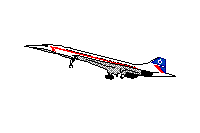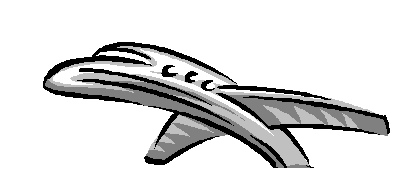
On matters
of flight
The airfoil drama:
So how do things fly?
This is a question of simple mechanics: airplanes push themselves up the inclined planes which are attached to their fuselage, as birds and bats push themselves up the inclined planes which are attached to their bodies. For insects it is a bit different.
What confuses people is that they confuse physics with engineering. Designing safe, energy-effective airfoils is difficult business for humans, and it takes nature some time to adapt animals for active flight. And of course, the wings of animals and machines are aerodynamic constructions to reduce drag and turbulence and save energy.
But, please! Go to an airshow. Have a look at the airfoils of stunt planes: they are thin, simple, straight, symmetrical, flat ironing boards, enabling the pilot to do what he likes as long as he keeps them at an overall positive angle to the ground. Speed, rather power, does the rest. As long as the plane ( or bird ), by driving it's own attached inclined plane through the surrounding air, climbs as fast than it falls down through its own weight, it stays where it is. The rest of the business is applied fluid mechanics, complicated but not really necessary for the understanding of the basic physics of an airborne flight. Look up model or flight magazines: I've seen pictures of propelled kitchen tables in flight if kept at the right angle; about 4 to 10 degrees, if I remember correctly. Yes, wings of bigger flying animals or machines are curved in different outlines to allow the air to be declined smoothly. But the wings of butterflies and other insects are flat.
There is still silly talk of faster air flow pulling at the top of the wings pulling the wings up. If this were true, an airplane flying upside-down would smash into the ground with the combined forces of gravity AND air flow. I have done so, and I didn't. I've seen others do it, and they didn't. And still, even some pilot's handbooks force the flying school pupils to repeat this nonsense. Apart from the proposed suction causing feathers, metal sheeting or any other fabric to be pulled off the top of the wing with the full weight of the flying object: How much "suction" could an air foil develop at best at it's top before creating a vacuum? 1 atmosphere. At sea level. And near the top of the atmosphere at 10,000 meters, where 400-ton aircraft now sail along, and what about fighter aircraft flying even higher? Please explain. In fact, a vacuum cannot pull anything, as nothing can do nothing. ( That, by the way, is one way of explaining why 'stalling' is so dangerous: a vacuum forms over the wings if it is tilted to steep, which can be seen in clouds or streams form of condensing air humidity. ) There is no "suction" just as there are no "cold rays". The universe is not symmetrical - if it was, it probably would not exist.
Stand in front of a commercial airliner ( or a bird ) and have a look: The wings are shaped like turbine blades. But they are symmetrical in mirror ( one twisted clockwise, one counterclockwise ), so that they push the airliner or bird up off the ground instead off spinning it on it's body axis when the speed-generated airflow hits them from the front. The necessary airspeed is provided by engine or muscle power, momentum, or wind. That, in principle, is all. For all disbelievers: there have been numerous, even quite recent, attempts to increase the wing lift by increasing the air flow over the top. All have failed miserably.
Of course, there are other ways to fly, too: pure floating ( balloons; no speed necessary, atmosphere only ) and pure momentum ( cannon balls; no atmosphere necessary, speed only ). A flying insect swims in the surrounding air and is therefore limited in size and weight by the density of the surrounding atmosphere.
A bird is airborne, gliding on it's middle wing. In flapping, the wings twist, using only the outer bit ( the hand ) to generate thrust, weaving them through the surrounding air in a sinus curve, as a diver would use flippers on his feet, weaving them up and down through the water ( resp. air ) instead of just splashing around. This twisting of the wing can be observed at any sea shore, where a head wind keeps the bird in place at human eye level. The inner wing carries the bird, the outer wing generates the necessary thrust.
The thrust this weavy flapping generates is quite fantastic: try it out while sitting on a turnstool and waving a big fan on an outstretched arm. Once it catches, you're off!




 me!
me!